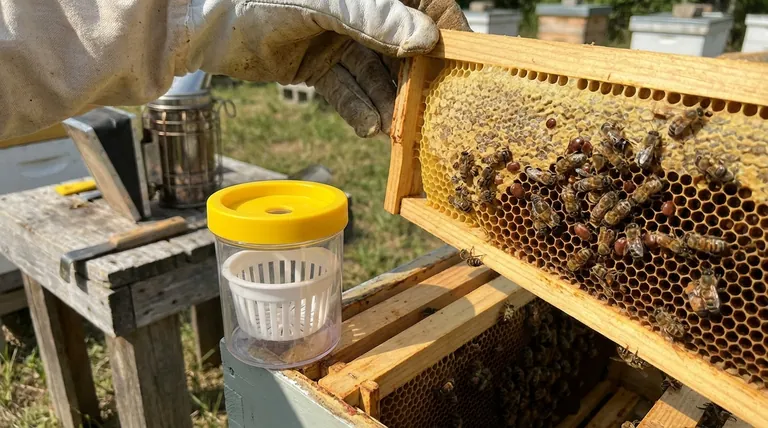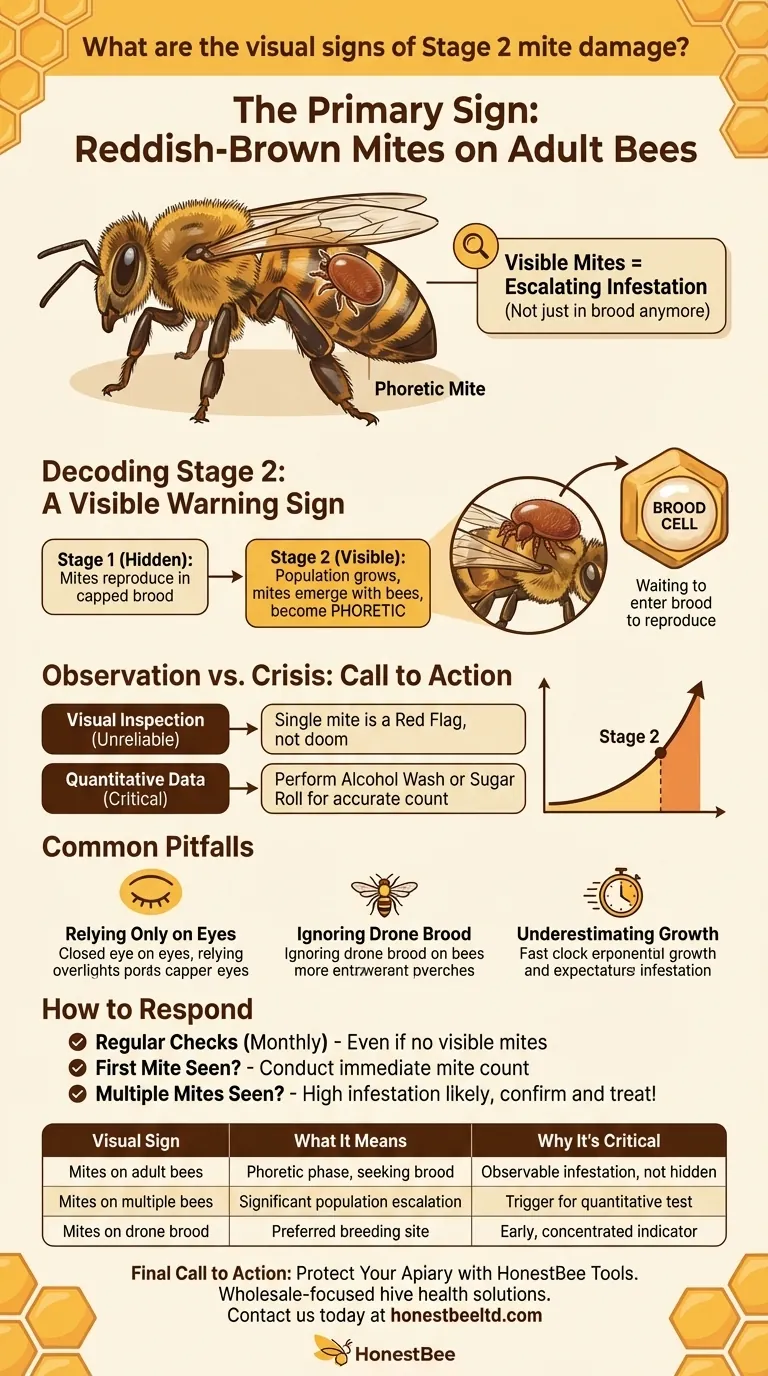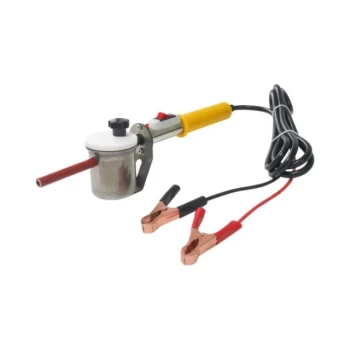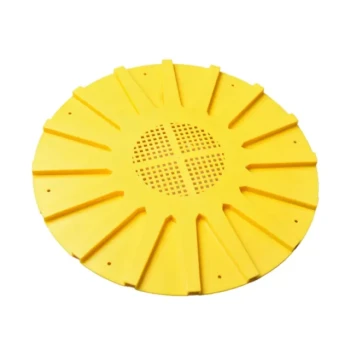The primary visual sign of Stage 2 Varroa mite damage is the presence of the mites themselves on the bodies of adult bees. You will spot these reddish-brown, oval-shaped parasites, known as phoretic mites, attached to the abdomens of worker or drone bees as you inspect your frames. While seeing a single mite doesn't signal an immediate colony collapse, it is an undeniable indicator that the infestation has reached a significant, observable level and requires immediate assessment.
The transition from a hidden problem to a visible one is the essence of Stage 2. Seeing mites on adult bees means the Varroa population is no longer contained within the capped brood and has reached a level where proactive monitoring is no longer optional—it's critical.

Decoding Stage 2: A Visible Warning Sign
Stage 2 isn't a formally defined scientific term but is widely understood by beekeepers to represent a moderate and escalating Varroa infestation. It's the point where the mite population becomes large enough to be easily seen with the naked eye during routine inspections.
The Phoretic Phase Explained
When you see a mite on an adult bee, it is in its phoretic phase. This means it is "hitching a ride."
During this phase, the female mite feeds on the bee's fat body tissue, weakening its host. More importantly, she is waiting for an opportunity to enter a brood cell with a larva just before it's capped, which is where she will reproduce.
Why You're Seeing Them Now
In the early stages of an infestation (Stage 1), the vast majority of mites are hidden from view, reproducing within the capped brood cells.
You begin to see them on adult bees in Stage 2 because their population has grown significantly. As more infested bees hatch, more mites emerge with them, leading to a higher number of phoretic mites throughout the hive.
The Critical Distinction: Observation vs. Crisis
The presence of visible mites is a crucial data point, but it's one that requires interpretation. The key is to understand that Stage 2 is a call to action, not a declaration of failure.
A Single Mite is a Red Flag
Seeing one or two mites does not mean your colony is doomed. It means the invisible threat you are supposed to be monitoring for has now become visible.
The Need for Quantitative Data
Visual inspection alone is an unreliable method for assessing the true level of infestation. The mites you see represent only a fraction of the total population, with up to 80% hiding in the brood.
Stage 2 sightings are the trigger to perform a quantitative test, such as an alcohol wash or a sugar roll, to get an accurate mite count. This data tells you if you have crossed the treatment threshold.
Common Pitfalls in Assessing Stage 2
Relying solely on visual cues can lead to a false sense of security or a delayed response. Understanding these common mistakes is crucial for effective Varroa management.
Mistake 1: Relying Only on Your Eyes
The most dangerous mistake is assuming that "no visible mites" means "no mite problem." An infestation can grow to a critical level long before mites become easily noticeable on adult bees.
Mistake 2: Ignoring Drone Brood
Varroa mites preferentially infest drone brood due to its longer development cycle, which allows female mites to produce more offspring. Always inspect drone bees and drone brood, as they can be an early indicator of a rising mite population.
Mistake 3: Underestimating the Growth Rate
Seeing a few mites can feel manageable, but the Varroa population grows exponentially. An infestation that appears moderate in the spring can overwhelm a colony by late summer if left unchecked.
How to Respond to Stage 2 Signs
Your response should be guided by the frequency of your sightings and, most importantly, by quantitative data.
- If your primary focus is early detection: Perform regular (at least monthly) alcohol washes or sugar rolls, even if you don't see any mites on adult bees.
- If you have just seen your first mite on a bee: Immediately conduct a mite count to determine the infestation level. Your result will tell you whether you need to treat now or can monitor and re-test soon.
- If you are seeing mites on multiple bees across several frames: Your hive is likely at or well above the treatment threshold. Confirm with a quick count and prepare to implement your chosen treatment method immediately.
Proactive monitoring is the foundation of sustainable beekeeping and the only reliable way to keep your colonies safe from Varroa destructor.
Summary Table:
| Visual Sign | What It Means | Why It's Critical |
|---|---|---|
| Reddish-brown mites on adult bees | Mites are in the phoretic phase, feeding on bees and seeking brood. | Indicates a growing, observable infestation that is no longer hidden in brood cells. |
| Mites visible on multiple bees | The mite population has escalated significantly. | A clear trigger to perform a quantitative test (e.g., alcohol wash) to assess the true infestation level. |
| Presence on drone bees/brood | Drone brood is a preferred breeding site for Varroa. | Can be an early, concentrated indicator of a rising mite population in the hive. |
Protect Your Apiary with the Right Tools
Seeing mites on your bees is a clear call to action. Effective Varroa management requires reliable monitoring equipment and treatment supplies. HONESTBEE supplies commercial apiaries and beekeeping equipment distributors with the wholesale-focused tools needed for proactive hive health.
From mite testing kits to treatment solutions, we provide the durable, high-quality equipment that underpins successful, sustainable beekeeping.
Contact HONESTBEE today to discuss your wholesale supply needs and ensure your colonies are protected.
Visual Guide

Related Products
- Varroa Easy Check Mite Tester Kit Counter Alcohol Wash Jar
- Durable 12V Oxalic Acid Vaporizer for Varroa Mite Treatment Beehive Beekeeping Tool
- Oxalic Acid Vaporizer 12V for Bee Varroa Mite Treatment
- 12V Bee Mite Removal Evaporator Oxalic Acid Vaporizer for Bee Fumigation Treatment 180W Atomization
- Langstroth Screen Bottom Board for Beekeeping Wholesale
People Also Ask
- How often should varroa mite checks be performed using the alcohol wash method? Optimize Your Apiary's Health
- What is the Varroa EasyCheck used for? Accurate Mite Monitoring for Healthy Hives
- What is the most reliable method for assessing Varroa mite infestations? Master Proactive Hive Management
- What are some popular methods to measure Varroa mite load in beehives? Compare Accuracy & Bee Safety
- Why is an alcohol wash preferred over powdered sugar rolls? For Accurate Varroa Mite Management



















